| Bastet The Egyptian cat-headed goddess Bastet was strictly a solar deity until the arrival of Greek influence on Egyptian society, when she became a lunar goddess due to the Greeks associating her with their Artemis. Dating from the 2nd Dynasty (roughly 2890-2686 BC), Bastet was originally portrayed as either a wild desert cat or as a lioness, and only became associated with the domesticated feline around 1000 BC She was commonly paired with Sakhmet, the lion-headed goddess of Memphis, Wadjet, and Hathor. Bastet was the "Daughter of Ra", a designation that placed her in the same ranks as such goddesses as Maat and Tefnut. Additionally, Bastet was one of the "Eyes of Ra", the title of an "avenger" god who is sent out specifically to lay waste to the enemies of Egypt and her gods. The cult of Bastet was centered in Bubastis (located in the delta region, near modern- day Zagazig) from at least the 4th Dynasty. In the Late Period Bubastis was the capital of Egypt for a dynasty, and a few kings took her name into their royal titles. Bubastis was made famous by the traveler Herodotus in the 4th century BC, when he described in his annals one of the festivals that takes place in honor of Bastet. Excavations in the ruins of Tell-Basta (the former Bubastis) have yielded many discoveries, including a graveyard with mummified holy cats. |
 |
 |
 |
 |
 |
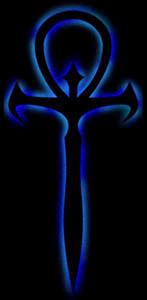 |
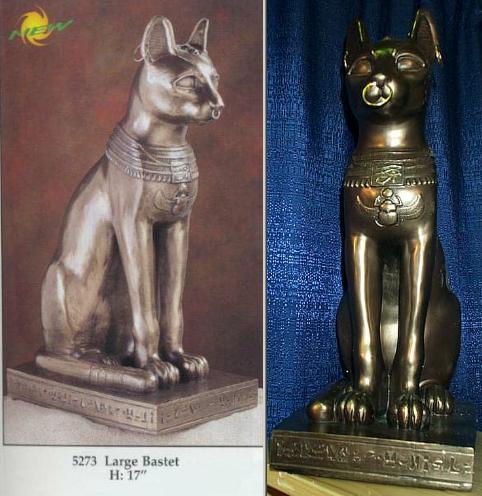 |
 |
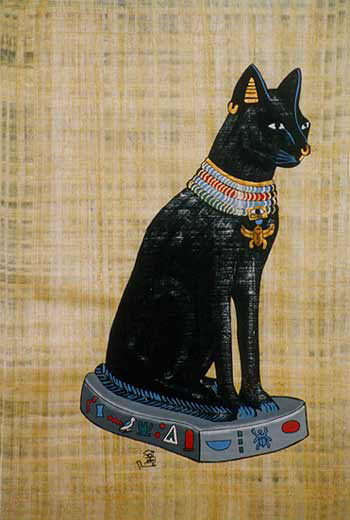 |
 |
 |
 |
 |
| Feline Goddess & Protector of the Home The cat goddess was frequently associated with Isis, and cats were common in the temples of Isis. She is usually presented as a cat-headed woman, or as a cat sitting. She often carries a sistrum, and having kittens playing at her feet. In her purely cat form she usually wears a gold earring and other jewerly. The combination of fierceness and calm found in many cats is a good metaphor for the nature of the Goddess. One of her titles is "Daughter of Isis". Bastet was especially worshipped in her city, Boubastis which was known for its festival where it was said more beer was drunk on that day than on any the rest of the year in all of Egypt. She is thus associated with divine intoxication, dancing and music as well as sexuality. In her cat descendants she is a living symbol of the Egyptian Goddess of love. Whether because you wish to please the goddess of love by placing her on your alter, or to simply acknowledge the pleasure of her presence; a statue of Bast will create a feeling of protection, fertility and honor in your home. Bast also presides over enchantment, and protects her worshipers against contagion and evil spirits. The beauty of her eyes is like the moon in its phases. She has always been credited with the most important function of deity which is healing. Bast is a beneficient and kindly Goddess, unlike her sister Sekhmet, her alter aspect who represents rage and retribution. Sekhmet being the destroying energy of the unrelenting noonday desert sun. Both personify the feminine principle, each in her own unique way |
 |
 |
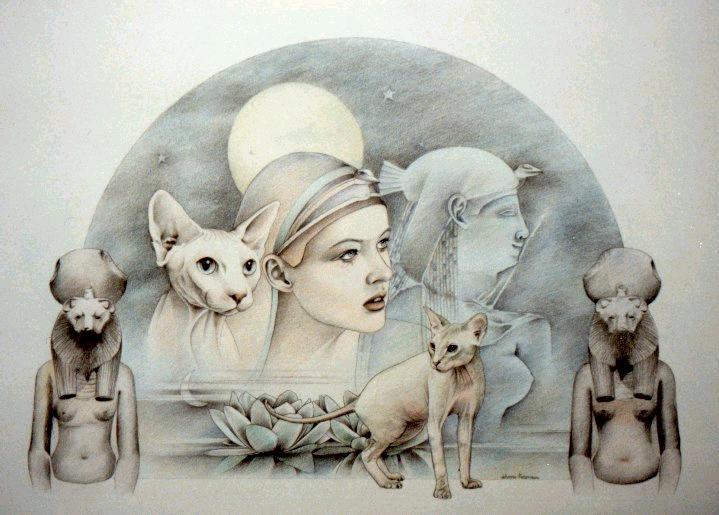 |
 |
| Bast: The Egyptian Cat Goddess, benevolent aspect of Hathor and Sekhmet, represents joyful sexual celebration of the union of men and women and enhances paychic ability |
| Sekhmet: The Egyptian lady of magick, Sekhment is the wrathful aspect of Bast and the dark side of Hathor. The Sphinx is a monument to her. She is protectress of diviners |
| The Tearer "The Tearer" is first and foremost a protectress; specifically of the royal house and the Two Lands. Bast defended Ra against the serpent Apep Representation: A woman with the head of a domesticated cat, sometimes holding a sistrum. Relations: Daughter and wife of Ra, mother of Khensu and Maahes. Other Names: Bast, Bastet, Tearer, Goddess of Cats Bastet was a lion goddess, but then became associated with the common cat, while the goddess Sekhmet overtook the role of the lion goddess. All Egyptians loved cats, so it was natural that they would think kindly of a deity associated with the affectionate animal, who caught snakes and chased mice. Since snakes were an anathema to Ra the solar god, cats were considered sacred to the god Ra. Cats were often mummified and buried at Bubastis, the sacred place of Bastet. Function: Goddess of the domestic cats, thus is a household protector. Imagery: Appears as a cat or as a woman with a cat�s head. |
 |
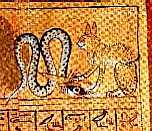 |
| Sistrum The sistrum was a sacred percussion instrument used in the cult of Hathor. The sistrum consisted of a wooden or metal frame fitted with loose strips of metal and disks which jingled when moved. This noise was thought to attract the attention of the gods. There are two types of sistrum, an iba, was shaped in a simple loop, like a closed horse-shoe with loose cross bars of metal above a Hathor head and a long handle. The seseshet had the shape of a naos temple above a Hathor head, with ornamental loops on the sides. The rattle was inside the box of the naos. They were usually carried by women of high rank. |
| Bastet - Egyptian Cat Goddess Egyptian cat goddess. A goddess of the home and of the domestic cat, although she sometimes took on the war-like aspect of a lioness. Daughter of the sun god Re, although sometimes regarded as the daughter of Amun. Wife of Ptah and mother of the lion-god Mihos. Her cult was centered on her sanctuary at Bubastis in the delta region, where a necropolis has been found containing mummified cats. Bast was also associated with the 'eye of Re', acting as the instrument of the sun god's vengeance. She was depicted as a cat or in human form with the head of a cat, often holding the sacred rattle known as the sistrum. |